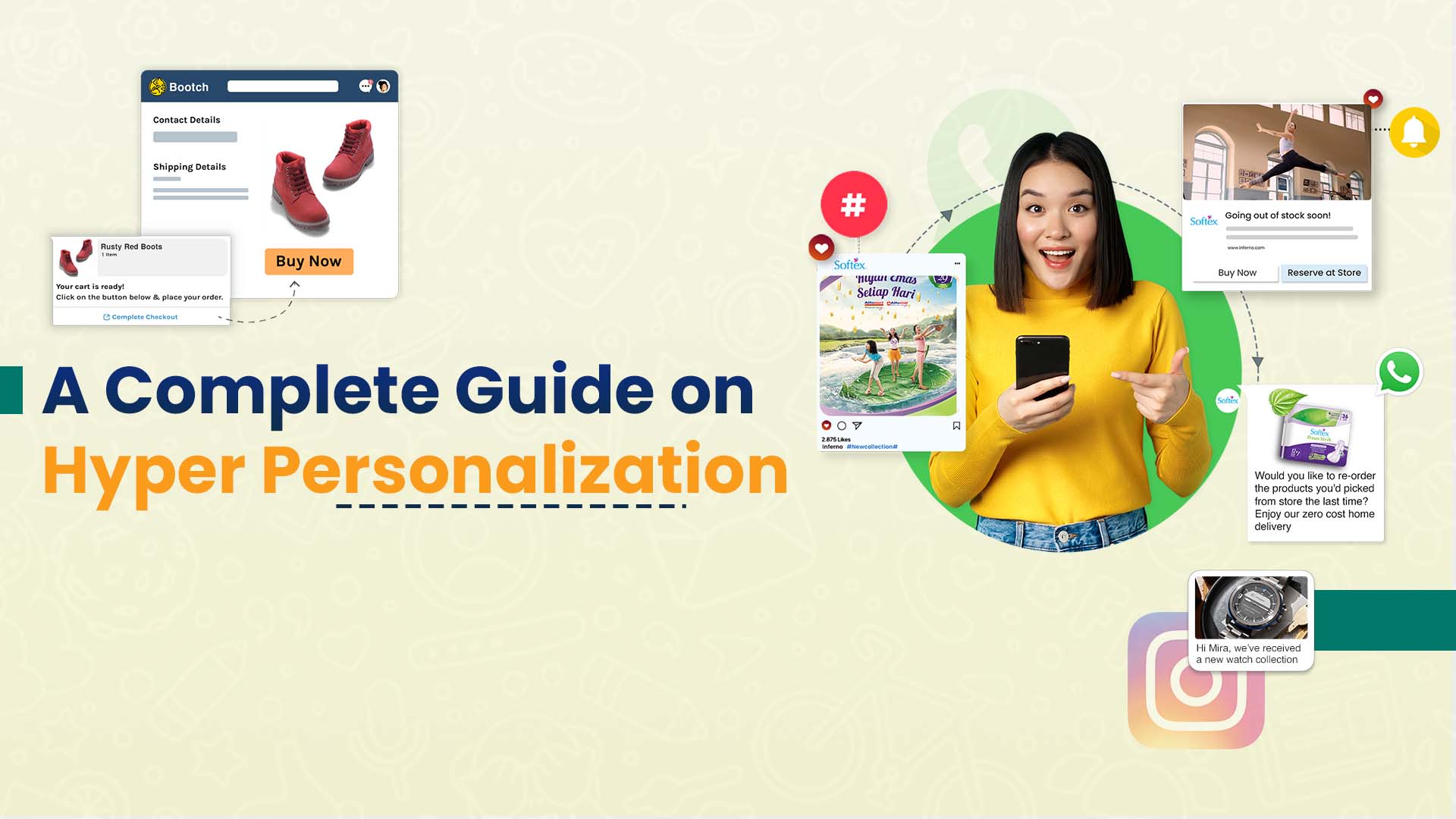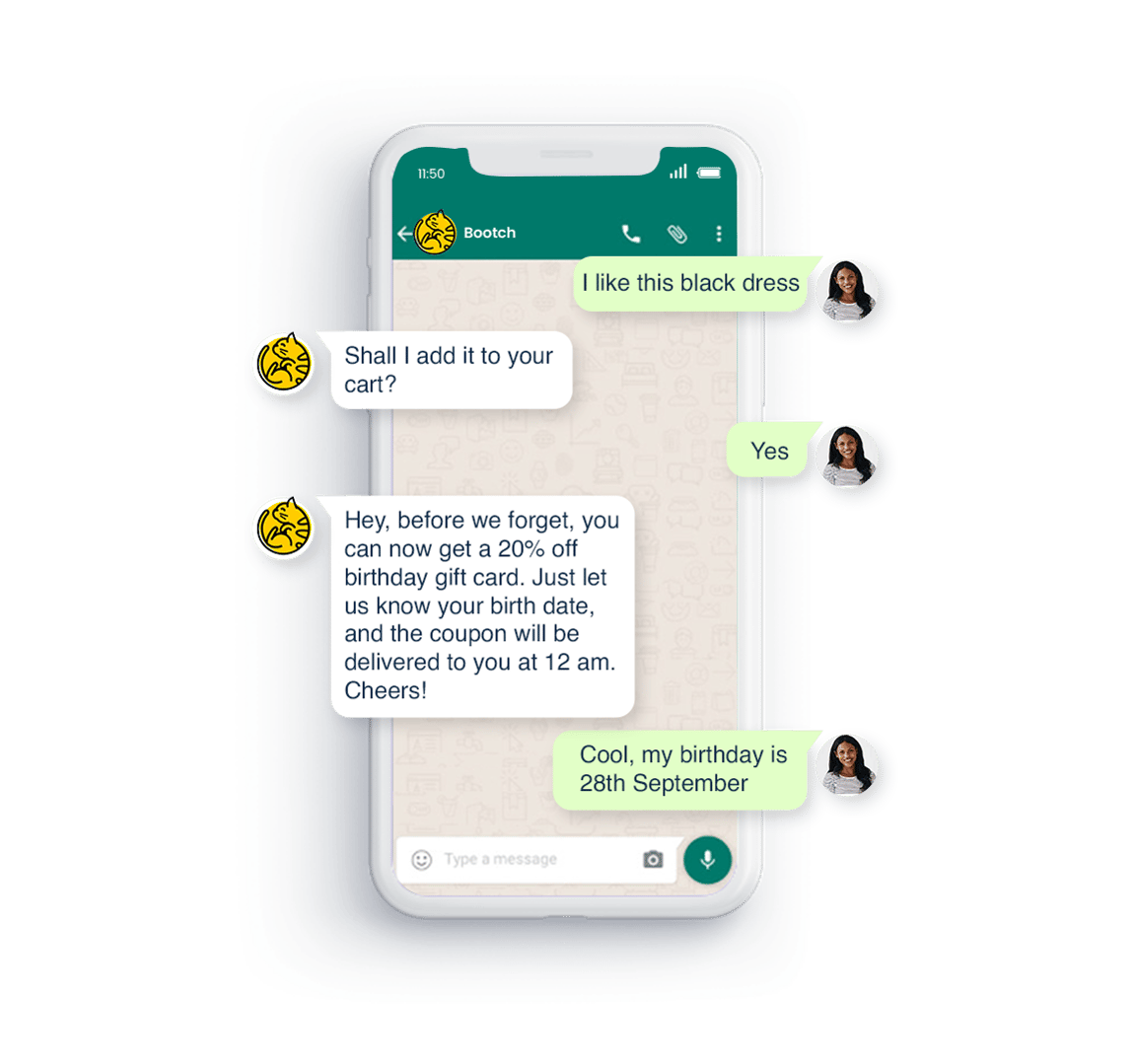5 Reasons to use Conversational Messaging in E-commerce
Conversational messaging in ecommerce constitutes the use of well-crafted digital user journeys that can be used to boost customer lifetime value
Hyper-personalization enables brands to meet these expectations, drive conversions, and bring higher returns. Explore more in this article

As early as 2019, brands began experimenting with hyper-personalization, a marketing strategy that ranks several notches above personalization. Hyper-personalization aims to draw the consumer's engagement, nudging them to initiate instant call-to-action. Typically, this means buying a product or service without hesitation. Jeff Bezos put it succinctly when he said, "We see our customers as guests to a party, and we are the hosts. It's our job every day to make every important aspect of the customer experience a little bit better."
Today, consumer expectations have superseded what traditional marketing strategies can offer, and hyper-personalization enables brands to meet these expectations, drive conversions, and bring higher returns.
In today's digital world, the number of customer touchpoints has shot up. There are social media platforms, messaging apps, websites, newsletters, and blogs, to name a few. The old paradigm of building marketing campaigns targeted at generic consumer segmentation buckets across a few channels no longer works.
Consumer behavior shifts have nudged brands to be present on multiple channels and to leverage analytics, AI, and automation, to tailor communication to a consumer's individual preferences.
There are several consumer behavioral shifts and market forces that are collectively fueling hyper-personalization. Here's a glimpse:
✅The average consumer installs about 40 apps on their smartphones, and consumers may be using their phones for up to 17.5 hours a day. Collective usage of social media, messaging, email, and other functional apps leads to cognitive overload. Hence, the faster a consumer finds what they are looking for, the quicker is their experience likely to convert into a transaction.
✅The "one-size-fits-all" marketing engagement approach reduces customer satisfaction and delight. There is also a definitive shift in consumer expectations where they believe that the brands they patronize must understand their needs. Consumers want customized product recommendations and engagement, from lingerie and snacking to travel bookings and financial services.
✅In an increasingly competitive marketplace, brands compete with multiple players for market share. Consumers, on the other hand, are spoilt for choice. In this scenario, brands are looking to increase customer lifetime value, which means building meaningful engagement that leads to significant and personal long-term relationships.
Traditional personalization leveraged basic information such as name, geography, and purchase history to customize communication. On the other hand, hyper-personalization leverages the consumer's real-time behavioral data to build a highly individualized consumer experience journey across all touchpoints. This can include data points such as time of the day when they logged in, location, type of device, average spends, pages visited, engagement type, and cart abandonment details to build a dynamic, real-time consumer experience.
For example, with personalization, a consumer would receive an email that addresses them by their first name. Hyper-personalization enables personalized product recommendations that land in their inbox or reach them via push notifications just as soon as they log into a platform. A data-centric approach takes consumer journeys to the next level.
As brands engage with consumers at multiple points, the amount of data being generated has shot up exponentially. Big data presents an opportunity to understand consumers' preferences to serve them accordingly. Those brands that can capitalize on the trend of converting data into valuable insights have a competitive advantage in building hyper-relevant marketing campaigns.
A combination of these three is hyper-personalization gold, as they collectively enable it across multiple channels at scale. Data generated can be converted into valuable data points and leveraged to enhance the individual consumer journey.
The flipside of having access to so much data and leveraging it to curate personalized user journeys is that brands must work harder to build consumer trust. As consumers start seeing value in the overall consumer experience, they will be more comfortable sharing data. Brands that win the consumer trust game while leveraging hyper-personalization have a competitive advantage.
The shift to hyper-personalization is helping brands in very tangible ways. Here are the key benefits:
This marketing approach delivers relevant engagement to consumers based on their real-time online activities, making it an "in the moment" experience. Hyper-personalization features include round-the-clock personalized customer service, dynamic landing pages, and real-time customer segmentation, leading to increased customer lifetime value, brand recall, and trust.
Hyper-personalization features such as recommendation engines, data-driven content generation, in-depth product targeting, and dynamic pricing have a direct impact on revenue growth by converting non-buyers into customers.
Tools that enable brands to use hyper-personalization also empower them to do it at scale. This is especially valuable as businesses expand.
Workflow automation leads to streamlined work cycles, reduced labor costs, and reduced customer acquisition and retention costs.
While hyper-personalization has established itself as a tool to meet several business outcomes, implementation can be a nightmare for brands, especially as they scale. This is where a superior engagement tool can help brands meet their hyper-personalization goals. Here are some of the benefits:
Conversational commerce, an arm of hyper-personalization, aims to make shopping an effortless, personalized experience for digital shoppers. This experience enables brands to engage with consumers via messaging apps, where the consumer is already active.
By running conversational commerce activities and campaigns on platforms like WhatsApp, consumers can make sales inquiries and access personalized recommendations and any instant communication that enhances their shopping experience. As of 2021, India had over 487 million WhatsApp users, the quantum which is all set to grow.

Here are several ways in which brands are leveraging conversational commerce to build hyper-personalized engagement:
✅Businesses can launch profiles on popular messaging apps where consumers spend a significant part of their time. For instance, a brand can create a profile on WhatsApp and build an intimate and meaningful relationship with consumers here. Engagement tools support special messaging formats that enable brands to offer a start-to-end shopping experience on messaging apps. Rather than wait for consumers to come to your eCommerce website, you reach consumers where they are already present.
✅WhatsApp Business and WhatsApp Business API profiles can use automated messaging to respond to commonly asked questions, while specific automated responses can be set up to address queries that need personalized input. This gives the customer a chance to start a conversation from a channel they are already using.
✅Brands can effectively use conversational commerce on chat apps to run various marketing campaigns, from cart-recovery initiations to promotional campaigns, purchase confirmations, delivery alerts, and reminders. Consumers are less likely to think of it as spam since the communication is relevant to their needs.
✅Brands are also offering digital storefronts on WhatsApp. Customers can connect with store managers, book appointments, reserve products, and buy online pickup at the store.
In a survey by Hubspot, 88% of American marketers reported seeing measurable improvements due to personalization and a 10% boost in business results. 78% of internet users reported that personally relevant content by brands increased their intent to make a purchase.
Here are some brands that are leveraging hyper personalization:
Lifestyle fashion brand Bewakoof with its over 5 million active users, was looking to increase customer engagement. They wanted to engage inactive and at-risk consumers and reduce drop-offs. They leveraged IntelliBid, an algorithm by Vizury, which helps identify users with the top conversion rates by using a user score. The segmentations were based on variables such as the time users spent on the app, value of average order, conversations, etc. Accordingly, a user was mapped to a specific score.
Ad creatives were customized based on user scores, which means users saw ads with different images and products based on their browsing data. Bids differed for different ad sets. Eventually, higher bids were for those users identified by the algorithm as more likely to make a purchase, while others received lower bids. At the same time, the average cost per click was maintained.
Vizury ran real-time campaigns on Facebook and its properties, comprising carousel ads and collection ads with configurable dynamic attributes, including price, product image, and product category. This approach ensured that users saw products that they had recently visited.
Results: These strategies enabled Bewakoof to take a streamlined, focused approach to leverage the right advertising networks, thus bringing down the cost per acquisition by 3X. Conversion rates increased by 4X, and the paid acquisition program increased by 5X.
India's largest online hotel booking platform and leading air travel aggregator, Goibibo, was looking to boost overall engagement on its app. They wanted to bring back drop-off users to the app and build a relevant experience for their buyer journey. For instance, if a user abandons a hotel or air travel search and then revisits the platform, they would be directed to the same page from their previous session. Goibibo was also looking to bring down the costs per visit.
By partnering with Vizury, Goibibo was able to address both challenges successfully:
1. Goibibo leveraged Vizury's programmatic advertising engine, enabling brands to create intelligent user segments based on over 40 variables, including previous buys, digital customer engagement history, and an average cost of spending per order. Hyper-personalized advertising campaigns were developed for ad display platforms, including Facebook. Based on the predictions given by Vizury's engine, each user saw a diverse ad set relevant to their segmentation. This approach helped to address the issue of customer and user drop-offs.
2. Next, Vizury tracked the ratio of users landing on the Goibibo app after clicking on the post. Based on emerging data, Goibibo started only serving ads on those platforms delivering higher clickthrough and landing rate, as both metrics are equally important. Even though Vizury's publisher inventory comprises multiple networks, they strategically decided to only focus on Facebook due to fewer redirects. These tweaks led to a higher ratio of users landing on the Goibibo app.
Results: The following strategies reduced cost per session by 20%, while the click-to-session ratio increased by 38%, and booking on Goibibo's mobile app increased by 6.5%.
According to Statista, the intelligent use of data is one of the biggest hurdles for businesses as they grapple with hyper-personalization needs. Partnering with a tech-enabled omnichannel customer engagement platform can help brands address all challenges and build all aspects of hyper-personalized engagement from scratch across a wide range of channels. Ease of use, strategic marketing, measurability tools, and access to superior analytics empower brands to address various marketing challenges and drive up Return on Marketing Investment.
Conversational messaging in ecommerce constitutes the use of well-crafted digital user journeys that can be used to boost customer lifetime value
User journey provides a comprehensive understanding of your users. Read this blog to know how Zalora optimized its campaign to improve the user...
Conversational marketing on WhatsApp has made it possible for brands to engage and personalize the shopper’s experience at every stage of their...
Be the first to know about new B2B SaaS Marketing insights to build or refine your marketing function with the tools and knowledge of today’s industry.